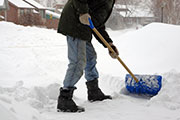- Skip Storing This Everyday Product in the Fridge Door
- Green Tea + B3 Pairing May Boost Brain Health
- Navigating Your Midlife Crisis: Embracing New Possibilities
- City Raccoons Showing Signs of Domestication
- Mapping the Exposome: Science Broadens Focus to Environmental Disease Triggers
- One Week Less on Social Media Linked to Better Mental Health
- Your Brain Changes in Stages as You Age, Study Finds
- Some Suicide Victims Show No Typical Warning Signs, Study Finds
- ByHeart Formula Faces Lawsuits After Babies Sickened With Botulism
- Switch to Vegan Diet Could Cut Your Greenhouse Gas Emissions in Half
Protect Yourself in Icy Temperatures, Heavy Snow


As the winter’s first big snowstorm hits the Midwest and an Arctic blast barrels toward the East Coast this week, experts are offering tips on how to deal with the cold and snow.
Temperatures in some areas are dipping into the single digits, and that’s when adequate clothing is key, said Dr. Robert Glatter, an emergency medicine physician at Lenox Hill Hospital in New York City.
“It’s important to dress in layers and to keep your head, face and ears covered in the event of a blizzard,” he said. “Exposed areas — including your ears, nose as well as fingers — are at high risk for frostbite after as little as 10 to 15 minutes in sub-freezing temperatures, and this risk is increased in the elderly.”
And although dehydration is more often linked to very hot temperatures, Glatter said that it’s important to stay hydrated in cold snaps, too.
Water is best, he added. “Avoid alcohol and caffeine since these beverages can quickly lead to dehydration,” Glatter said. “Energy drinks may be tempting, but the excess sugar and caffeine can place you at risk for dehydration.”
Snow shoveling is an unfortunate side effect of winter for many, but shoveling carries its own hazards, said Dr. Robert Gotlin, director of orthopedic and sports rehabilitation at Mount Sinai Beth Israel Hospital in New York City.
His tips for safe snow removal:
- Layer your clothing to keep your lower back warm.
- Stretch your muscles before heading out into snow.
- Try not to bend at the waist, rather do so through the hips.
- Do not bend the knees more than 90 degrees because this increases stress across the knee joint.
Glatter added that people should also “take frequent breaks while shoveling snow as this activity can be dangerous in older persons who do not frequently exercise.”
He cautioned: “If you develop chest pain, it’s important to stop shoveling and call 911.”
Extreme cold can also bring on frostbite to exposed areas of the body, Glatter warned. “If you develop persistent tingling or numbness or discoloration of your fingers or toes after exposure in cold temperatures, proceed to the closest emergency department,” he said.
Finally, cold temperatures outside may lead to the use of space heaters inside. But it’s important to make sure that these devices operate safely.
“People who use indoor space heaters need to be aware of the risk of carbon monoxide poisoning if there is a malfunction in the equipment,” Glatter said. “Carbon monoxide is odorless, colorless and tasteless — check all heaters before winter arrives.”
“Indoor heaters may also represent a fire hazard if electrical cords are frayed or if there are overloaded outlets,” he added. “Make sure to check all connections and equipment before winter sets in.”
More information
There’s more on cold weather safety at the U.S. Centers for Disease Control and Prevention.
Source: HealthDay
Copyright © 2025 HealthDay. All rights reserved.










